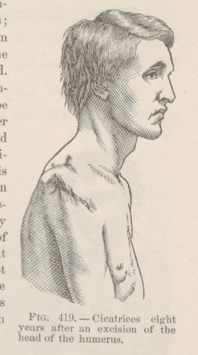Title: Rice, B. E.
Source text: The Medical and Surgical History of the War of the Rebellion. (1861-65.), Part 2, Volume 2 (Washington, DC: Government Printing Office, 1876), 547.
Civil War Washington ID: med.d2e31102
TEI/XML: med.d2e31102.xml
CASE 1519.—Private B. E. Rice, Co. H, 7th Wisconsin, aged 31 years, was wounded at Gainesville, August 26, 1862, and was treated in the regimental hospital until August 30th, when he was transferred to Washington, and admitted to Columbian College Hospital, and discharged the service December 22, 1862, Surgeon T. R. Crosby, U. S. V., certifying to: "Gunshot wound, requiring resection of the head of the left humerus." On March 28, 1870, Dr. L. G. Armstrong, of Boscobel, Wisconsin, reported: "Gunshot wound, ball entering the shoulder joint from the front. Removed to Washington, D. C., Columbian College Hospital. Head of humerus exsected after a number of days; secondary operation. Wound entirely healed in six months. Bones anchylosed, yet the arm cannot be raised from the side, admitting only of moderate forward and backward motion. The wound is healed soundly, yet large loss of tissue occurred. The humerus is two inches shortened. Arm can be used only from the elbow downward. Amount of neuralgic pain only trifling. General health but little influenced by the operation." Dr. Armstrong also forwarded a daguerreotype of Mr. Rice, taken March 21, 1870, which is copied in the wood-cut (FIG. 419). Examiner J. M. Jenkins, of Sibley, Iowa, reported, May 20, 1874: "Gunshot wound of left shoulder. Head and neck of humerus resected. Very large cicatrix; the deltoid, long head of biceps, infraspinatus, and pectoral muscles were, apparently, severed, and the nerves injured. The arm is shortened one and a half inches. The shoulder is very much atrophied, and the arm and forearm are somewhat smaller, and are easily chilled; he has but little use of the limb. Disability increasing, and may become total. The arm has but little motion, and the forearm and hand are very weak." Upon searching the case, it has been impracticable to obtain any important particulars of its earlier history. Surgeon D. Cooper Ayres, 7th Wisconsin, reported the admission of the patient to regimental hospital, with a "serious gunshot wound of the shoulder." Dr. Crosby does not describe the operation or mention the name of the operator. All of the reporters agree that the operation was on the left side. The position of the cicatrix is reversed in the daguerreotype, as copied in the wood-cut, and appears as of the right side. This is an error very liable to remain undetected in illustrations prepared by photography, even after careful scrutiny.
